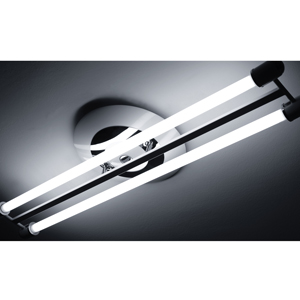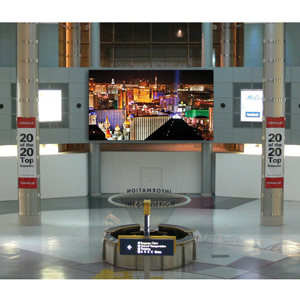For 25 years, Home Automation Inc. (HAI) has provided innovative, quality home automation products to professionals in the low-voltage market. These products
 |
| HAI’s commercial controller allows customers to reduce their energy use and control outdoor sign lighting, fluorescent lighting, plug-in lamps, and more. |
offer security along with luxury and convenience, making HAI’s system a suitable choice for customers who want both security and energy management. HAI does this by integrating all of the various subsystems together using a centralized, computerized head-end.
Over those years, HAI’s integrators have diversified, expanding their reach to include building management systems (BMS). HAI engineers have done likewise, expanding the company’s automation platform to encompass commercial and institutional applications.
“The HAI Omni Pro II is available in a commercial version, the Omni Commercial Controller. This controller is UL listed for commercial burglary,” said Jay McLellan, HAI president and CEO. “The Omni Commercial Controller includes all of the advanced features of the Omni Pro II, but with the added benefit of an attack-proof enclosure. The OmniPro II in its commercial form can be expanded up to a total of 176 zone inputs and 136 voltage outputs.”
Louis Katona, president of VidCorp Security Systems Inc., Houston, Texas, is one of those HAI dealers that gradually expanded his company’s reach into the commercial market. Today he uses the Omni Pro II to provide his clients with BMS, access control, video surveillance, and other services. Katona understands that HAI products are not limited to home control — they also work in many commercial and institutional applications.
“HAI products are the foundation on which we’ve built our business over the past 15 years,” Katona described. “HAI’s automation technology allows us to design systems that can control lighting, HVAC, security, access control, video surveillance, and more. When HAI is added to the design plan, we have the tools necessary to create a powerful BMS.”
Because HAI’s Omni Commercial Controller bears a UL Commercial Burglary listing, Katona is able to satisfy insurance companies and others that require it. The listing itself is an indication of how resilient HAI’s alarm panel is to attack.
Penal Facility Puts HAI to the Test
In 2003, Katona met with officials from a mid-size prison facility to discuss their need for integration among dissimilar subsystems within their complex. There were four areas where integration was lacking. They were BMS, which included sump pumps, lighting and temperature control; along with basic facility security, access control, and the control of motorized vehicles using a special radio system.
“We sat down with them to talk about their problems and what VidCorp could do for them. Their needs were extensive, but I knew the HAI platform would enable us to accomplish what they wanted,” Katona related. “Besides the basics, they needed to automatically start and stop a number of motor vehicles on queue, something that my local competitors were not able to do.”
There were specialized motor vehicles in a sally port that often sit for extended periods without being used. During winter months this can become a problem when the batteries in these vehicles fail.
“They were assigning people to go out there to start these vehicles and sit with them. They had to open the garage doors and put the fans on in order to remove the exhaust,” Katona said. “This is in a secured area under the control of their security personnel. I asked them what would be the difference if we automated the process. They could watch the area on camera to assure security and proper shutdown of all systems, including the closing of the garage doors and the shutdown of the ventilation fans.”
Prison officials decided that Katona’s idea was worth exploring. After some debate it was decided VidCorp would install automation in one bay to see how it worked.
“First we installed a prototype. We equipped the vehicle in the middle bay to start on queue. A camera in the vicinity allows guards to monitor the process,” Katona described. “The lights come on and the [garage] door opens automatically. The vehicle starts and the fans come on. Fifteen minutes later the vehicle shuts off and the garage doors close. Thirty minutes afterward the exhaust fans shut down.”
Prison officials liked what they saw; Katona’s company installed the same system in two other secure bays.
Also included in the mix are a sophisticated camera system, electronic security, lighting and HVAC control, and electronic access. Each one of these subsystems is controlled in some fashion by the HAI OmniPro II control panel. The result is a more secure, energy-efficient facility with which prison officials are well satisfied.
“The perimeter security is controlled by several layers of devices. When an intrusion is detected the entire perimeter area is flooded with powerful spotlights. The surveillance system tracks movement and relays all information to mobile units as well as in-house security personnel,” Katona described.
The Technology

|
One of the secrets behind the high level of integration that Katona installed at the prison involves the use of RS485 and RS232 by way of three ports built into the OmniPro II’s motherboard. A combination of HAI’s automation software and a robust RS485 data bus allows dealers to extend control up to 4,000 feet; 50 to 150 feet using RS232.
“On the DC project we extended the keypad bus (RS485) to connect the control panel to a number of expansion enclosures. The 485 bus is what links all the accessory devices to the [head-end], along with thermostats, keypads, expansion panels, and other devices,” Katona said. “The 485 gives us more operating distance than 232, and it allows us to daisy-chain these devices all around a facility. We usually homerun these devices anyway so we can more easily isolate problems when they come up.”
For example, an 8-relay module in conjunction with the Omni Commercial Controller allows control of subsystems, such as lighting, cell doors, and motorized gates. “We support two PLC protocols: UPB (Universal Power Bus) and X-10 (Standard, Extended, and Compose),” McLellan said. “We implemented standard protocols for both so that it is interoperable with all brands.”
A 16-zone input/16-zone voltage output module offers even more expansion capability. According to McLellan, “You can connect up to four 4-relay modules or two 8-relay modules to convert these 12VDC outputs to Form C relay outputs. However, these modules work only with the OmniPro II panel.”
Because these outputs are programmable using HAI’s software, Katona’s company can control other aspects of the facility, such as cameras. When someone activates a card reader, security personnel can see who it is by programming a nearby camera to pan/tilt until it can see the door in question. This is accomplished by triggering presets in a matrix camera controller using programmable relay outputs in an HAI relay module.
Another means of control at the penal facility is video guard tours, invoked by schedules contained in the OmniPro II’s firmare. “When there’s no one in the security room after a certain hour we can preset the system to move cameras anywhere prison officials want,” Katona said.
The access control portion of the HAI system integrates with environmental and people sensors. Integration includes outdoor temperature and lighting sensors as well as water level and a variety of security sensors, such as motion detectors. The HAI main controller also allows management to assign employees to specific doors on certain days, between certain hours of the day. The OmniPro II Commercial controller can regulate the order by which doors are released or opened, something that is extremely important in prison facilities.
“The facility has roll-up doors with an interlocking system that requires that they be opened in a given sequence. All of this is controlled by card readers combined with the HAI OmniPro II,” Katona explained. “We added an intercom system at key doors so those who approach outside their regular access day/time, or arrive at a door they are not authorized to enter, can get help from security personnel inside the facility.”
The level of integration afforded by HAI’s commercial platform has made it possible for Katona’s clients to realize a higher level of integration at a price point that they would normally not be able to afford. As a bonus, the electronic security portion of the system provides the eyes and ears necessary to operate a successful BMS component while providing excellent security against breakouts and break-ins. Because the HAI line offers much functionality, dealers need stock only a limited number of control panels and expansion devices. — Contributed by HAI.
|
PROJECTS in the News The Greenbrier Resort in White Sulphur Springs, W.V., has a new video surveillance system in its Casino Club gaming facility. The system, installed by North American Video, uses IP cameras from Pelco. The IP cameras include a mixture of megapixel and high-resolution imaging and are integrated with a recording structure designed to ensure that all available storage is symmetrically utilized. * Samsung will provide 130 46-inch liquid crystal display screens for McCarran International Airport in Las Vegas that will be engineered to create four separate video walls. According to the Clark County Department of Aviation, McCarran will be the first airport to feature a video wall of this kind. Programming for each display will consist of paid advertising and airport messaging. * The Donald E. Stephens Convention Center in Rosemont, Ill., uses vandal-resistant color dome cameras from Rainbow CCTV. The 500-TV-line units have 4-9 mm lenses and are protected from attack by aluminum housings and polycarbonate domes. Local integrator Omni-1 Electronics has installed 350 of the cameras. * Pressurized dome cameras from Infinova have been installed on both sides of the Panama Canal to view ships and vessels waiting their turn to go through the locks. The goal is to verify that vessels stay within their assigned spaces while waiting to help prevent damage to the channel and locks. The cameras also will provide evidence to enable Canal authorities to penalize rule-breakers. |





